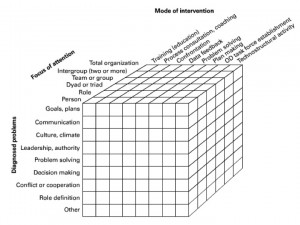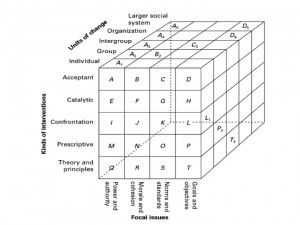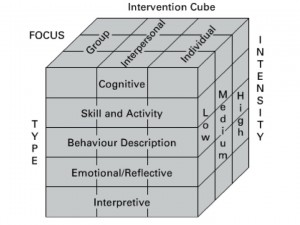Posts tagged ‘Intervention Phase’
Attributes of The OD Practitioner – The Intervention Phase
OD practitioners, like OD interventions come in many shapes and sizes. Unlike many other organisation roles, the is multi-faceted and is hard to define in regards to the work they do.
However, despite the difficulty in describing what it is an OD practitioner does the skills they need are much easier to define.
The following is a list of attributes which the OD practitioner should possess if they are to successfully navigate the intervention phase of an .
- Methodical approach
- Leadership and ownership of interventions
- Guiding hand
- Relational
- Theoretical founding in intervention design
- Resource planning
- Collaboration
- Facilitater
- Trainer
- Developer
- Create learning opportunities
- Ongoing progress evaluation
- Flexibility and Adaptability
- Calming presence
- Tough and supportive
- Discerning
- Tolerant of Ambiguity
- Safe pair of hands
- Shared responsibility
- Enabling the Client to be independent once intervention phase is done
At every stage of the OD intervention phase, the OD practitioner must remind themselves that they are their to help improve the client organisation and each individual participant to grow, learn and develop in a positive way.
By their very presence the OD practitioner will be moving the organisation system forward, consciously or unconsciously. The ability of the OD practitioner in design, developing and delivering interventions will come to nothing is the OD practitioner is unaware of the impact they are having on the client system.
Further more they should be a hub around which participants will generate ideas and positively seek change, all the while providing insight, building trusting relationships and staying true to their own values and beliefs.
The Three Cubes of Intervention – Organisation Development
come in a range of shapes and sizes, but what distinguishes them from other experiences of organisation change is that the interventions are planned with the purpose of improving organisational effectiveness.
“An intervention is a change effort or a change process. It implies an intentional entry into an ongoing system for the purpose of initiating or introducing change.” Rothwell
An Organisation Development Intervention therefore requires the OD practitioner to develop a structured plan within the existing organisational system. The activity may be at an individual, team, department, function or organisational level, but regardless of the size of the intervention the intervention should disrupt the status quo and develop the participants, shifting to new, improved levels of performance.
The variety of interventions available to the OD practitioner are wide ranging and as such require different skills and knowledge depending on the complexity of the intervention. Organisation Development interventions are always bespoke, never off the shelf, because they need to reflect the needs of the organisation and participants at a particular point in time. It is therefore recommended that OD practitioners build their interventions around the ‘three cubes of intervention model.’
Schmuck and Miles (1976) developed the ‘OD Cube’ to help the practitioner focus on the three interacting dimensions that should be considered in the intervention design phase;
- The Diagnosed Problem
- The Focus on Attention
- Mode of Intervention
A second cube was developed by Blake and Mouton (1985), the consulcube is considered to the be the most comprehensive overview elements of interventions included;
- Kind of Intervention
- Focal Issues
- Theories of Change
Reddy (1994) focuses on the process work completed by consultants, primarily within a team or group environment, although it can be applied more widely. The three dimensions of the Reddy Cube are;
- Focus of Intervention
- Type of Intervention
- Level of Intensity
Applying the Three Cubes
should check progress against the ‘three cubes of intervention model’ principle to ensure discipline and rigour in the intervention design in order to deliver an intervention which is built cross-dimensionally. The cube framework guides robust design whilst still allowing room for the OD practitioner to use their imagination.
Three Cubes Of Intervention Design Checklist
- What problems have been identified through the Diagnostic phase?
- What specific issues should the intervention focus on?
- What level within the organisation system is the intervention aimed at – Individual, group or organisation wide?
- What elements of the organisational system is the focus of attention upon?
- What is the role of the OD practitioner in the intervention?
- How many participants in the organisational system will be impacted?
- How much exposure will participants have to the intervention?
- What impact are you intending the intervention to have?
- What mode of intervention will you employ?




